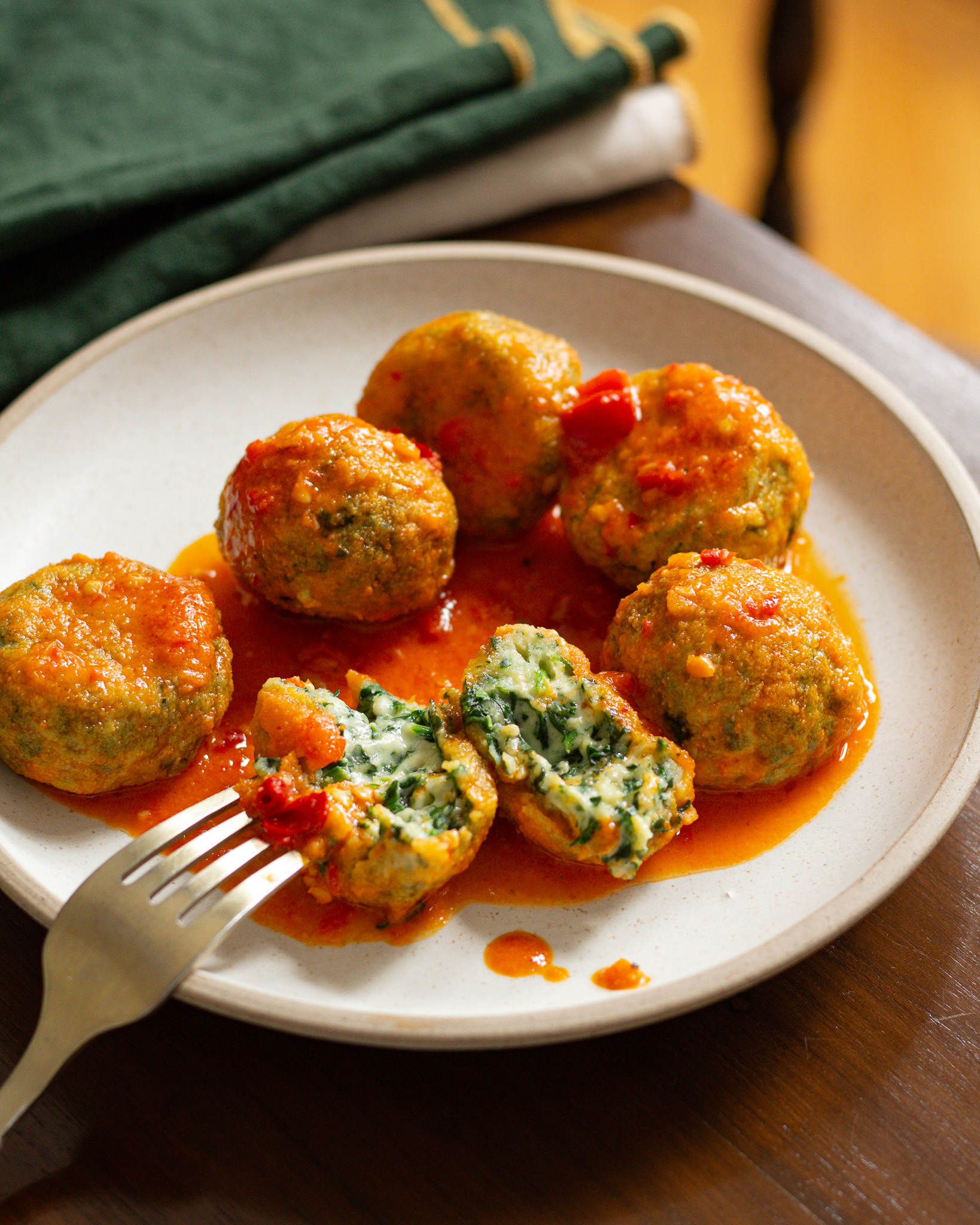Spinach & Ricotta Gnudi
5.0
(2)
Your folders
Your folders
Prep Time: 20 minutes
Cook Time: 20 minutes
Servings: 20

Ingredients
Export 10 ingredients for grocery delivery
Instructions
Step 1
Add the 12 ounces of ricotta to a fine mesh sieve. Suspend it over your sink (or a bowl) and let it it drain. I am supremely lazy and only do this for 15 minutes, but if your ricotta has a particularly high amount of water content (you'll have water pooling at the top or see a significant amount of moisture in the curds), then you'll have to drain for up to 2 hours. You want your ricotta to be firm and holding its shape in a half "ball" after it leaves the sieve.
Step 2
Add the 9 ounces of spinach to a large heat-proof bowl and cover it with boiling water. Make sure all the spinach is submerged and let it wilt in the hot water for 1-2 minutes, or until it is shrunken in size by half. Transfer it to a bowl of ice water.
Step 3
Squeeze all the water out of the spinach (very important!) and transfer it to a cutting board. Chop it up as finely as possible.
Step 4
Add the spinach and ricotta to a large mixing bowl. Crack in the egg, add in 1/2 cup parmesan, 1/3 cup bread crumbs, 1/2 teaspoon lemon zest, 1/4 teaspoon freshly grated nutmeg, 1 teaspoon Diamond Crystal kosher salt, and mix.
Step 5
Add the 1/2 cup of all-purpose flour to the bowl in two batches. Gently mix until combined. Don't mix too much, that might cause your gnudi to get tough.
Step 6
Dust a quarter sheet pan with 2 tablespoons of semolina flour. Use a 3-tablespoon cookie scoop to portion the dough into 20 gnudi. Set them on top of the floured sheet pan and dust them with another 2 tablespoons of semolina flour.
Step 7
Use your hands to roll the gnudi into balls, dusting with more semolina flour as needed. Set them in the fridge to chill for 1 hour minimum, but up cover them and they can chill in the fridge for up to 5-6 hours is my sweet spot, since the longer they chill the more of a pasta "shell" they will have after boiling.
Step 8
When you are ready to cook, set a large pot of water over high heat and bring it to a rolling boil. Salt the water with a heaping tablespoon of Diamond Crystal kosher salt.
Step 9
If this is your first time making gnudi, test one dumpling first. Gently place it in the boiling water and wait until it floats to the top, typically in 4 minutes. After it has begun to float, let it boil an additional minute to set. Transfer it to a lightly floured dish towel or to a paper towel.
Step 10
Now you can boil all the rest of your gnudi. Repeat the same method, waiting for them to float to the top, then letting them boil one more minute to set. They are tender when they first come out of the water, but they firm up as the rest on the floured dish towel.
Step 11
Once your gnudi are finished, leave the pot of salted water on the stove but turn off the heat. Place a large sauté pan on the burner next to it and begin the Calabrian butter sauce.
Step 12
Set the pan over medium heat and add 2 tablespoons of salted butter and 2 tablespoons of chopped Calabrian chilies. Let the butter melt, but don't let it brown. Add a 1/4 cup of pasta water from the large stock pot. Swirl this all together as the base of the sauce.
Step 13
Continue to add the butter one tablespoon at a time, allowing each tablespoon to melt into the sauce. After you have added 4 tablespoons total, add another splash of pasta water. As the sauce simmers, this water will help the sauce thicken into a smooth, spicy sauce. Add the remaining butter, continuing with the same method. If you find the sauce ever needs to be a bit more viscous, add a slash of pasta water.
Step 14
Remove the heat from the sauté pan and add the gnudi. Give them a few mixes to coat them in the sauce. Then serve!